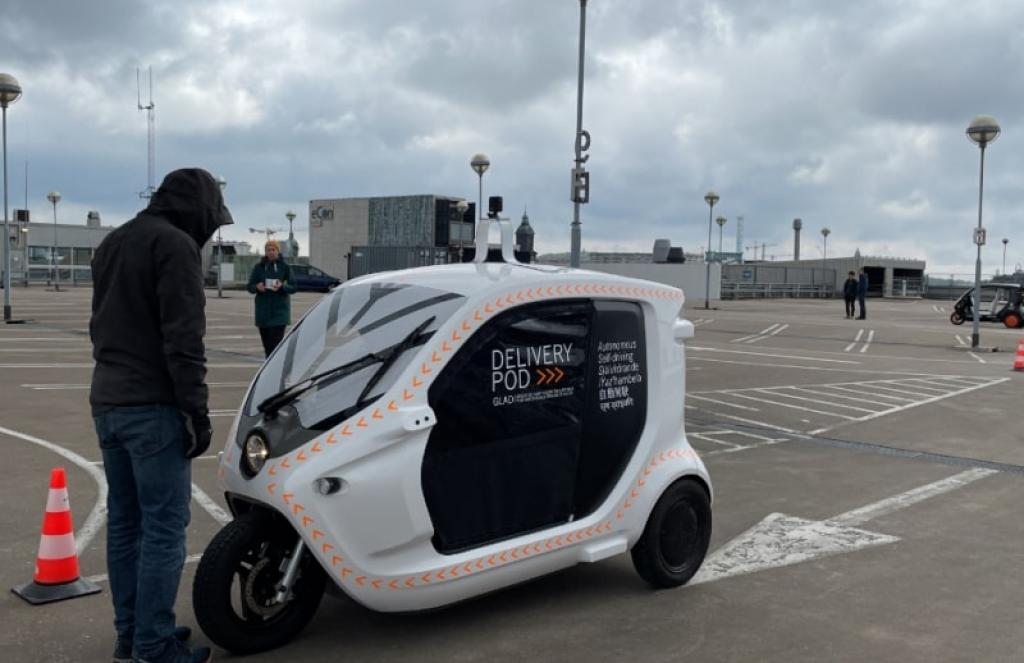Thessaloniki gets ready for its metro launch in November
The underground rapid transit lines have been under construction for almost two decades due to various project delays
 TheMayor.EU logo
TheMayor.EU logo 
The research project took place in a Gothenburg shopping centre, Source: RISE Research Institutes of Sweden
Swedish research project tried to get closer to answering this question
How will self-driving vehicles interact with pedestrians on the urban streets? That is a valid question that arises with the ever-increasing prominence of AI technology in mobility. It is also a question, which a Swedish research project used as a departing point when testing autonomous delivery vehicles.
The name of the project in question, which took place last month in Gothenburg’ Nordstan shopping centre, was GLAD (Goods delivery during the Last mile with Autonomous Driving vehicles). It does make one glad, indeed, that they opted for that acronym.
On a more serious note, the GLAD project aimed to investigate and create knowledge about trust and acceptance for these types of vehicles in Sweden. The Swedish Transport Administration funded the project. The Research Institutes of Sweden (RISE), Aptiv, Clean Motion, Combitech and Halmstad University conducted the user study.
The purpose of the study was to investigate, in a controlled manner, how pedestrians interact with and experience small self-driving delivery vehicles. Each pedestrian experienced different traffic situations and interpreted the vehicle's intention in the given situation.
The vehicle's driving behaviour was designed to communicate its intention in various ways, such as giving way to a pedestrian. The study lasted for two days and involved study participants from the general public.
“A self-driving vehicle that clearly communicates its intention is expected to be more reliable and easier to accept in society,” explained Azra Habibovic, senior researcher at RISE.
However, there are challenges around this as movement patterns can be interpreted in different ways in different situations.
Clean Motion sees a future where small self-driving delivery vehicles are part of the supply chain in Sweden, especially when it comes to deliveries during the first and last mile.
“For this to become real, it is important that these vehicles behave in an acceptable way in traffic. Being able to test this in a realistic and unique environment in central Gothenburg is fantastic,” said Christoffer Sveder, Director Commercial Operations at the company.
The GLAD research project had a broad approach, from technology and human-machine interaction to business models and requirements for the digital and physical infrastructure. Clearly, this is just a preliminary step and the road to seamless integration between autonomous vehicles and pedestrian traffic will take some time to get internalized by society.

The underground rapid transit lines have been under construction for almost two decades due to various project delays

Now you can get your wine in Talence by paying directly in Bitcoin

That’s because the state has to spend money on updating the railway infrastructure rather than subsidizing the cost of the popular pass

Rethinking renewable energy sources for the urban landscape

The examples, compiled by Beyond Fossil Fuels, can inform and inspire communities and entrepreneurs that still feel trepidation at the prospect of energy transition

Now you can get your wine in Talence by paying directly in Bitcoin

The 10th European Conference on Sustainable Cities and Towns (ESCT) sets the stage for stronger cooperation between the EU, national and local level to fast track Europe's transition to climate neutrality.

At least, that’s the promise made by the mayor of Paris, Anne Hidalgo

The underground rapid transit lines have been under construction for almost two decades due to various project delays

At least, that’s the promise made by the mayor of Paris, Anne Hidalgo

Hostal de Pinós is located in the geographical centre of the autonomous region

Despite its church-y name, the district has long been known as the hangout spot for the artsy crowds

Urban dwellers across the EU are having a say in making their surroundings friendlier to people and the environment.

Forests in the EU can help green the European construction industry and bolster a continent-wide push for architectural improvements.

Apply by 10 November and do your part for the transformation of European public spaces

An interview with the Mayor of a Polish city that seeks to reinvent itself

An interview with the newly elected ICLEI President and Mayor of Malmö

A conversation with the Mayor of Lisbon about the spirit and dimensions of innovation present in the Portuguese capital














